Visits: 6
The best Android phones sport ever-smaller bezels and debut startling new design quirks. With more fantastic Android smartphones coming out every few months, it’s tough to pick the best one to suit your needs, but we’ve had lots of hands-on time to list the best that stand out from the rest.
For now, Samsung is still holding strong thanks to its talent for blending features, high specs, and exciting design alongside some stunning cameras – all exhibited in its reigning S10 line. We fully expect to see even stronger contenders from the upcoming Samsung Galaxy S11 lineup, which is set to launch in February 2020.
But given the advancements coming from competing Google Pixel phones, as well as Huawei’s top-tier specs nipping at Samsung’s heels, the roster of best Android smartphones will continue to debut exciting – and competitive – handsets. The OnePlus 7 Pro is a scrappy and less costly contender, but it’s tough to argue against the versatility of the Samsung Galaxy Note 10 Plus.
If you’re shopping for a new Android smartphone, be sure to check each of these handsets out, as you’ll see some you might not have been aware of or taken seriously – but we can assure you they’re all top quality picks.
You can also compare the list to our best phones and best unlocked phones to see how Android and iOS devices stack up. And, if you need mobile service to go with your phone, we can help you find the best unlimited data plan.
Without further ado, let’s take a look at the best Android phones on the market right now.
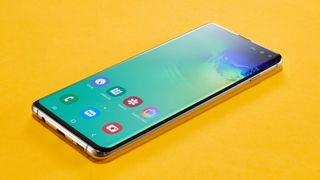
1. Samsung Galaxy S10 Plus
The best of the best
Release date: March 2019 | Weight: 175g/198g (ceramic) | Dimensions: 157.6 x 74.1 x 7.8 mm | OS: Android 9 | Screen size: 6.4-inch | Resolution: 1440 x 3040 | CPU: Snapdragon 855 / Exynos 9820 | RAM: 8GB/12GB | Storage: 128GB/512GB/1TB | Battery: 4,100mAh | Rear camera: 12MP wide + 12MP 2x telephoto + 16MP ultrawide | Front camera: 10MP + 8MP
Five cameras! All useful
Killer battery
Cool in-screen fingerprint sensor
Expensive
While the Samsung Galaxy S series has only made incremental improvements in recent years, the Galaxy S10 Plus makes a bit more of a substantial leap ahead with new features and an even sleeker look. While the other models in the series have their advantages, the S10 Plus is simply the best of the best – top specs, an expanded camera suite and some shiny new tricks.
The Snapdragon 855 at the phone’s core competes with the Apple A12 for the fastest chip you can get in phones, and the 8GB RAM makes browsing and gaming speedy. The baseline 128GB of storage is great, but you can also pick up the phone with 512GB – or even 1TB, if you pay for the premium ceramic-backed version (which boosts the RAM to 12GB). If that’s not enough, storage can be boosted by 512GB via microSD, bumping potential storage to 1.5TB…whoever should need it.
The phone has few drawbacks, with a huge 6.4-inch screen in the smallest frame we’ve seen thanks to a 93% screen-to-body ratio. The in-screen fingerprint sensor is cool, the ability to wirelessly charge other devices using the new Wireless PowerShare feature is even cooler, and we just love the clean look of the phone. Aces all around…if you’re willing to pay the (very) high price.
Read the full review: Samsung Galaxy S10 Plus
Note: why is the Galaxy S10 Plus higher-ranked than the regular Galaxy S10? Two words: bigger battery. If you want a somewhat smaller version of the same phone, scroll down.
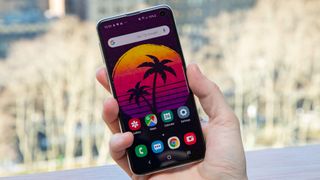
2. Samsung Galaxy S10e
Flagship specs at a lower price usable one-handed
Release date: March 2019 | Weight: 150g | Dimensions: 142.2 x 69.9 x 7.9 mm | OS: Android 9 | Screen size: 5.8-inch | Resolution: 1080 x 2280 | CPU: Snapdragon 855 / Exynos 9820 | RAM: 6GB/8GB | Storage: 128GB/256GB | Battery: 3,100mAh | Rear camera: 12MP wide + 16MP ultrawide | Front camera: 10MP
2019 flagship specs at 2016 prices
Most of its pricier siblings’ features
Small size for one-handed use
Misses out on in-screen fingerprint, etc
Smaller screen size worse for gaming/media
The Samsung Galaxy S10e is essentially the iPhone XR for Android: flagship specs at a lower price, with a few features shaved off to cut costs. And yet, the S10e is less of a compromise. It retains an AMOLED display (the XR’s is LCD), starts at 6GB of RAM and packs a second ultrawide rear camera to the XR’s single wide lens.
There are several things the S10e lacks compared to its pricier siblings, but nothing you’ll terribly miss: its side-mounted sensor is still more reliable than the in-screen fingerprint sensor on the S10 and S10 Plus. The 2x telephoto lens on its bigger siblings isn’t as useful as the ultrawide sensor it keeps.
But most importantly, it’s a cheaper, smaller phone in a sea of Android phones that are getting larger and pricier. The S10e is a more distinct alternative to the S10 Plus than the standard S10, which ends up being a middle child that doesn’t quite earn its price hike from its budget flagship sibling.
Read the full review: Samsung Galaxy S10e

3. OnePlus 7 Pro
The somewhat-affordable flagship reaches new heights
Release date: May 2019 | Weight: 206g | Dimensions: 162.6 x 75.9 x 8.8mm | OS: Android 9 | Screen size: 6.67-inch | Resolution: 1440 x 3120 | CPU: Snapdragon 855 | RAM: 6/8/12GB | Storage: 128/256GB | Battery: 4,000mAh | Rear camera: 48MP + 8MP + 16MP | Front camera: 16MP
Notchless display w/ pop-up selfie cam
In-display fingerprint scanner
All-day battery life
No headphone jack
Less affordable than previous models
The OnePlus 7 Pro is the pinnacle of the company’s design ethos: top-tier specs and software at sub-flagship prices. While the latter is still true – and you can get the standard OnePlus 7 a little cheaper, if you want – the pricetag for the elite OnePlus 7 Pro is creeping closer to the competitors it had previously outvalued.
But arguably, the upgrades from last year’s OnePlus 6T are worth it. The new handset adds a third ultrawide camera (following the Samsung Galaxy S10 line and Huawei Mate 20 Pro before it), retains its in-display fingerprint sensor, and even bumps up the resolution to an impressive WQHD+ (1,440 x 3,120) for a sharper-than-ever picture.
The OnePlus 7 Pro’s real innovation is a seamless, no-notch display – made possible by a persicope 16MP selfie camera. It pops up when taking selfies, but also when unlocking the phone with facial recognition. It even auto-retracts when the phone’s gyroscope detects it’s been dropped, though we haven’t tested how effective this is.
All in all, the phone is a solid upgrade over its predecessor, though its extreme value over leading flagships has diminished somewhat.
Read more: OnePlus 7 Pro review

4. Samsung Galaxy Note 10 Plus
Big, fast, premium, and pricey
Release date: August 2019 | Weight: 196g | Dimensions: 162.3 x 77.2 x 7.9 mm | OS: Android 9 | Screen size: 6.8-inch | Resolution: 3040×1440 | CPU: Snapdragon 855/Exynos 9825 | RAM: 12GB | Storage: 128/512GB (up to 1TB with card) | Battery: 4,000mAh | Rear camera: 12MP + 12MP + 16MP + TOF | Front camera: 10MP
The best screen on a smartphone
The best selfie camera around
Fun-to-use rear cameras
Handy S Pen stylus
Supremely expensive
Big and slippery design
Camera isn’t ‘the best’
Limited software ecosystem
The Galaxy Note 10 Plus is the most supreme this smartphone series has been, with a big gorgeous display, four rear cameras, and the same reliable S Pen stylus.
Following the Samsung Galaxy S10’s lead, the Note 10 Plus adds a 16MP ultrawide lens and a Time-of-Flight depth sensor. And the phonemaker has really leaned into the premium edge with the Plus, as it starts at 256GB of storage and 12GB of RAM.
Otherwise, not much will surprise you about this phone, which is okay: it’s less thick, has a bigger screen, and is more stylish than ever. It’s pricey yet powerful, with a bit more S Pen functionality.
Read the full review: Samsung Galaxy Note 10 Plus
Note: the Note 10 and Note 10 Plus are functionally the same smartphone, so we went with the larger version for its bigger battery. If you’d like the same stylus-paired flagship, take a look at our Samsung Galaxy Note 10 review.
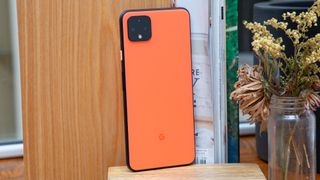
5. Google Pixel 4 XL
The best camera phone without the notch
Release date: October 2019 | Weight: 193g | Dimensions: 160.4 x 75.1 x 8.2 mm | OS: Android 10 | Screen size: 6.3-inch | Resolution: 1440 x 3040 | CPU: Snapdragon 855 | RAM: 6GB | Storage: 64/128GB | Battery: 3,700mAh | Rear camera: 12.2MP + 16MP | Front camera: 8MP
Top-of-the-line cameras
Simple, no-nonsense design
Face Unlock is finicky, no fingerprint sensor
Low storage options
Battery life is barely adequate
The Google PIxel 4 XL still takes incredible photos, but its curious features and disappointing battery life make this year’s version a bit tougher to recommend. New Soli radar components and a return to a thick top bezel instead of a notch make this a more conservative, but still stylish, phone.
The fingerprint sensor is gone, replaced by facial recognition unlocking that’s not quite on par with Apple’s Face ID – and not yet recognized by many banks, meaning the phone doesn’t have biometric authentication for financial apps. The new Motion Sense lets you control audio and alarms via aerial hand gestures, but it’s not used for much more than that – and works erratically to boot.
Other new features are neat, like Live Caption and live transcribing in the Recorder app, though those features are coming to the Pixel 3 series. Still, the Pixel 4 XL is a great phone with a minimal design style compared to the flashier flagships out there, and with a Snapdragon 855 chipset and 6GB of RAM, it’s powerful enough to get the job done. Just be prepared to recharge: the phone rarely lasts more than a day at full capacity, which is why we recommend the XL over the Pixel 4’s pitiful 2,800mAh battery.
Read more: Google Pixel 4 XL review
Note: since the regular Pixel 4 and Pixel 4 XL are virtually the same phone, we went with the larger one for its significantly better battery. But if you prioritize smaller phone size, check out our Google Pixel 4 review.

6. Samsung Galaxy S10
A fantastic phone with a less-clear identity
Release date: March 2019 | Weight: 157g | Dimensions: 149.9 x 70.4 x 7.8 mm | OS: Android 9 | Screen size: 6.1-inch | Resolution: 1440 x 3040 | CPU: Snapdragon 855 / Exynos 9820 | RAM: 8GB | Storage: 128GB/512GB | Battery: 3,400mAh | Rear camera: 12MP + 12MP 2x telephoto + 16MP ultrawide | Front camera: 10MP
Powerful and handy
Great suite of cameras
In-screen fingerprint sensor is cool
Unclear purpose compared to siblings
Too few upgrades for price bump from S10e
The Samsung Galaxy S10 is an incredible phone – a true flagship that ticks all the boxes and even has a few new tricks that make it a bit more than just an incremental upgrade over the Galaxy S9. But with the addition of the ‘budget flagship’ S10e to the S10 line, the standard edition is a bit harder of a sell.
Don’t get us wrong, it’s still a fantastic phone. Packing the latest Snapdragon 855 chip and doubling the RAM to 8GB makes the standard S10 a powerful device, and the baseline 128GB of storage is very welcome. The new in-screen fingerprint scanner is pretty cool, and the extra 2x optical telephoto and ultrawide lens are reasons alone to pick this over last year’s Galaxy S9. The new Wireless PowerShare is very handy in a pinch to charge other devices.
But for a noticeable price cut, you aren’t missing much if you opt for the S10e; and on the other side, for a bit higher price, the S10 Plus offers a slightly larger screen, another selfie camera for portrait depth, and a higher spec ceiling. Thus, the standard S10 is likely for folks who want a flagship that’s not too big, not too small, yet is powerful enough to last years of use.
Read the full review: Samsung Galaxy S10

7. Huawei P30 Pro
A killer camera that’s aging well
Release date: April 2019 | Weight: 192g | Dimensions: 158 x 73.4 x 8.4 mm | OS: Android 9 | Screen size: 6.47-inch | Resolution: 1080 x 2340 | CPU: Kirin 980 | RAM: 6GB/8GB | Storage: 128GB/256GB/512GB | Battery: 4,200mAh | Rear camera: 40MP + 20MP + 8MP + TOF | Front camera: 24MP
Four (FOUR!) cameras
Top specs, slick design
Huge battery
Limited carrier support in US
Only Full HD display
Huawei’s P series has always taken photography seriously, and the P30 Pro takes that to an extreme. Where other phones have struggled to fit more than a 3x optical zoom in ever-slimmer phones, Huawei circumvented that limit with a novel design: lay its lens stack along the phone’s length and use a mirror to reflect it out the rear cover. Hence the “periscope” lens, which manages 5x optical zoom, a 10x digital zoom and a baffling 50x full digital zoom.
The phone is no slouch in other departments, either, sporting Huawei’s latest Kirin 980 chip to reach speeds on par with Apple and Samsung flagships. Respectable RAM and storage round out the phone’s specs, but you’ll pick up the P30 Pro for its astounding photo capabilities, which include impressive DSLR-level ISO, per Huawei’s claims.
Alas, Huawei phones aren’t the easiest to get in the US – you’ll have to pick them up wholesale from a retailer, since no carrier currently sells the company’s devices and network support is limited. If not for that scarcity issue, this phone would likely rank higher in our list. But if sourcing your phone isn’t much of an issue, the P30 Pro looks to be a great choice.
Read our full review: Huawei P30 Pro
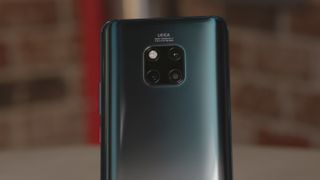
8. Huawei Mate 20 Pro
Huawei’s best phone and camera
Release date: November 2018 | Weight: 189g | Dimensions: 157.8 x 72.3 x 8.6mm | OS: Android 9 | Screen size: 6.39-inch | Resolution: 1440 x 3120 | CPU: Kirin 980 | RAM: 8GB | Storage: 256GB | Battery: 4200mAh | Rear camera: 40MP + 20MP + 8MP | Front camera: 24MP
In-screen fingerprint scanner
Great triple cameras
The UI needs refinement
High price
Huawei’s Mate 20 Pro isn’t the easiest to get your hands on in the US, but that doesn’t make it any less impressive a phone. It’s the best we’ve ever seen from Huawei, and stacks up well against all other Android phones.
It’s QHD display measures 6.39 inches and supports HDR10 for a great visual experience, as long as notches aren’t an issue There’s a fingerprint sensor embedded underneath the display as well. Inside, it’s offering impressive performance with Huawei’s own Kirin 980 chipset and 6GB or 8GB of RAM. It comes with plenty of storage and a large battery as well.
The camera offering on the Mate 20 Pro is truly impressive, with a combination of three cameras on the back and a super-sharp 24MP selfie camera. The rear camera system combines a 40MP wide-angle sensor, an 8MP telephoto sensor, and a 20MP ultra-wide sensor. The result is an incredibly versatile snapper with AI backing it up.
Read more: Huawei Mate 20 Pro review
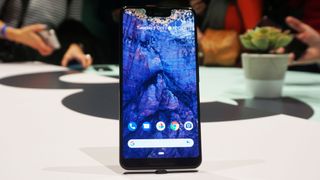
9. Google Pixel 3 XL
The best camera, a big screen, and a big notch
Release date: November 2018 | Weight: 184g | Dimensions: 158 x 76.7 x 7.9mm | OS: Android 9 | Screen size: 6.3-inch | Resolution: 1440 x 2960 | CPU: Snapdragon 845 | RAM: 4GB | Storage: 64GB/128GB | Battery: 3,430mAh | Rear camera: 12.2MP | Front camera: 8MP + 8MP
Superb camera phone
Solid battery life
Notch is hard to ignore
No headphone jack
Google’s Pixel 3 XL is a bit bigger and blockier than its smaller sibling, with sizable bezels that are less and less ignorable in 2019. The phone still has one of the best camera setups on the market, and it does that with just one rear sensor, two front-facing sensors, and a whole lot of software optimization, so credit where credit is due.
The design of the Pixel 3 XL isn’t quite as dazzling as the other offerings on this list, but it’s passable. It boasts a 6.3-inch OLED screen, but has a glaring notch at the top. The dual front-facing speakers help make up for that unsightly notch.
The internals are also competitive with the other flagship phones. And, with regular operating system updates guaranteed by Google, the Pixel 3 XL may have a longer life than some of the competition.
Read more: Google Pixel 3 XL review

10. LG G8 ThinQ
LG’s latest
Release date: April 2019 | Weight: 167g | Dimensions: 151.9 x 71.8 x 8.4mm | OS: Android Pie | Screen size: 6.1-inch | Resolution: 1440 x 3120 | CPU: Snapdragon 855 | RAM: 6GB | Storage: 128GB | Battery: 3,500mAh | Rear camera: 16MP+12MP | Front camera: 8MP
Vibrant OLED display
Portrait mode for video
Boring design
Too pricey
The recent LG G8 isn’t the company’s strongest offer in recent years. It launched with a design that wasn’t keeping up with its contemporaries, yet it had a price that was just about as expensive.
All the same, it comes with the latest Android experience and all the power that’s offered by the Qualcomm Snapdragon 855 chipset. That combination is enough to make it a worthwhile consideration as an Android phone.
The screen may have a notch cut out of the top, but it’s otherwise bright, sharp, and decently large. The cameras aren’t top-class, but with a wide angle lens on one, they offer some handy versatility. If you can find the LG G8 at a discounted price, some of its detractors get easier to forgive.
Read more: LG G8 ThinQ review
